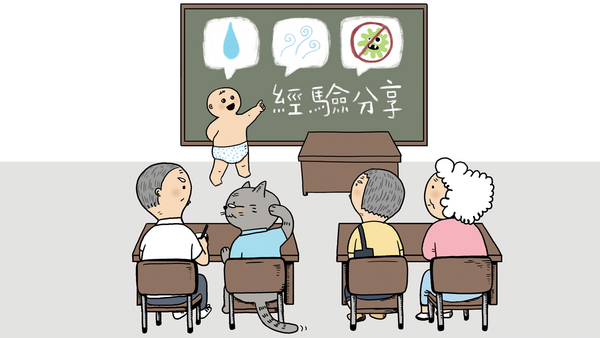As Hong Kong's population is aging, degeneration and illnesses are taking their toll in elderly's health which resulted in a rising incidence of incontinence and growing use of disposable adult diapers and pants. The Consumer Council has tested 21 adult diapers and 4 adult pants to help the elderly choose quality products of competitive prices. Choosing wisely and properly, one can save up to nearly HK$1,000 per month on diaper related expenses.
With reference mainly to the standards in the Mainland, the test parameters included: water vapour breathability, water absorption ratio, surface dryness, adhesiveness of tape fasteners and pH value. On a 5-point scale, the results showed that while all the samples scored satisfactorily in hygiene, the breathability performance of an overwhelming majority of the adult diaper models – 20 out of 21 – were deemed average or even poor. Only 1 sample was awarded 4 points while the remaining samples scored only 2 to 2.5 points. The performance of pants was relatively better and scored from 3 to 4 points respectively.
For both adult diapers and pants, the materials used must be breathable with high water absorption efficiency to keep the users' skin dry. As adults discharge more urine than babies, adult diapers/pants must possess considerable water absorption capacity to keep the urine from leaking. In the water absorption ratio test, the products varied quite considerably in their performance. Among the adult diapers, only 1 model scored 4 points while 6 models received 2 or 2.5 points only. For adult pants, 1 model was awarded 4.5 points but another model received only 2.5 points. Consumers are advised to be vigilant in their choices.
Surface dryness is another factor affecting the comfort of adult diapers/pants. The skin of elderly become more fragile with age. If adult diapers/pants with severe rewet issue failed to keep the skin dry, prolonged urine contact on skin will be prone to diaper rash. When diapers are contaminated with faeces, bacteria may infect users' urinary tract and cause urethritis. On surface dryness performance test, 5 models of adult diapers scored a high 4.5 point while 4 models with higher rewet tendency received 2.5 points only. For the adult pant samples, 2 models scored 4 points while 1 model with high rewet tendency received 2.5 points only.
In terms of hygiene of the product, none of the samples were found with formaldehyde or migrating fluorescent substances both of which may potentially cause allergy. Both the total bacterial count and yeasts and molds count were found to be below the Mainland standards limits indicating that the hygiene of all tested models are in compliance with the standards.
The price of adult diapers ranged from approximately $3.8 to $9.3 per piece. Expert opinion is that diapers should be changed every 4 to 6 hours. Assuming that an elderly needs to use 6 pieces of diapers per day, the monthly spending will amount to about $684 to $1,674, a difference of nearly $1,000 per month and over $10,000 annually. Adult pants are more suitable for elderly with higher mobility; the products are lighter than diapers, more fitting and convenient to wear but their prices are also higher ranging from $5.9 to $9.3 per piece. Assuming one needs to use 3 disposable adult pants each day, the monthly expenses will run from $531 to $837. The expenditure accumulated over years and, taking other essential medical expenses into account, could pose a heavy burden to the elderly without income and their families.
In addition, the samples varied considerably in the labelled measurements. For instance, samples labelled size large could vary, according to the information on the packaging, from the smallest of 70 cm (about 27 inches) to the widest of about 155 cm (61 inches). Most of the samples were without clear indication of the parts of the body of such measurements. Only 8 models stated clearly that those were waist and/or hip measurements. Consumers should be aware that different brands, even with the same way of marking, their actual measurement may vary substantially. When purchasing, consumers are advised to examine the measurement closely to choose the best fit waist or hip size. The Council recommended that manufacturers should improve the labelling, so that the elderly can choose their best fit diapers/pants.
When purchasing and using adult diapers/pants, consumers or care-givers of the elderly can refer to the following suggestions:
- Elderly facing incontinence issues should proactively seek medical attention to improve their situation, with proper treatment the problem can be improved;
- Elderly with good mobility can choose adult pants while those unable to look after themselves or bed ridden can opt for adult diapers;
- Correct usage can keep urine from leaking. Before using, pull on the leg guard of the diaper back and forth to ensure it is upright to prevent leakage;
- Choose adult diapers or pants with the right water absorption capacity suitable for the user's need; better water absorption capacity does not necessary mean a better choice. Too thick or bulky the product may cause inconvenience to the user;
- Pay attention to the product surface layer and see if it is soft enough or whether it will irritate the user's skin;
- If the skin of the elderly is intact and healthy, use diapers with high absorption capacity at night to avoid changes which will interrupt sleep. However, if the blood circulation of the user is poor, and the skin is easily redden or broken, change the diaper every 4 hours and change the sleeping position at the same time;
- To protect the user's skin, when changing diapers, use wet cotton wool to clean their skin, pat dry with tissue paper and apply protective cream.
The Consumer Council reserves all its right (including copyright) in respect of CHOICE magazine and Online CHOICE.



